Swinburne INF30030: Business Analytics in Healthcare Industry Report
VerifiedAdded on 2023/06/04
|12
|3204
|189
Report
AI Summary
This report provides a comprehensive overview of business analytics (BA) within the healthcare industry, highlighting its transformative impact. It begins by introducing the vast amounts of data generated in healthcare, including clinical, genetic, and lifestyle data, and how BA leverages this 'gold mine' to improve patient care and research. The report then explores the drivers behind BA adoption, such as the need for digitized personal data, and its applications in areas like e-health, telemedicine, and predictive medicine. It details the perceived benefits, including risk minimization in clinical trials, improved inter-agency collaboration, and reduced development costs. The report also delves into the BA strategies employed, which often involve coding and pooling data to identify trends that can influence management practices. Challenges like technical complexities and data fragmentation are discussed, as are the actual benefits, such as disease prevention, diagnostic support, and personalized treatments. Furthermore, the report addresses the drawbacks, especially the ethical and legal consequences of data privacy, and the need for a careful evaluation of benefits, risks, and costs. The report concludes by emphasizing the importance of targeting the right data to answer the right questions in this rapidly evolving field.
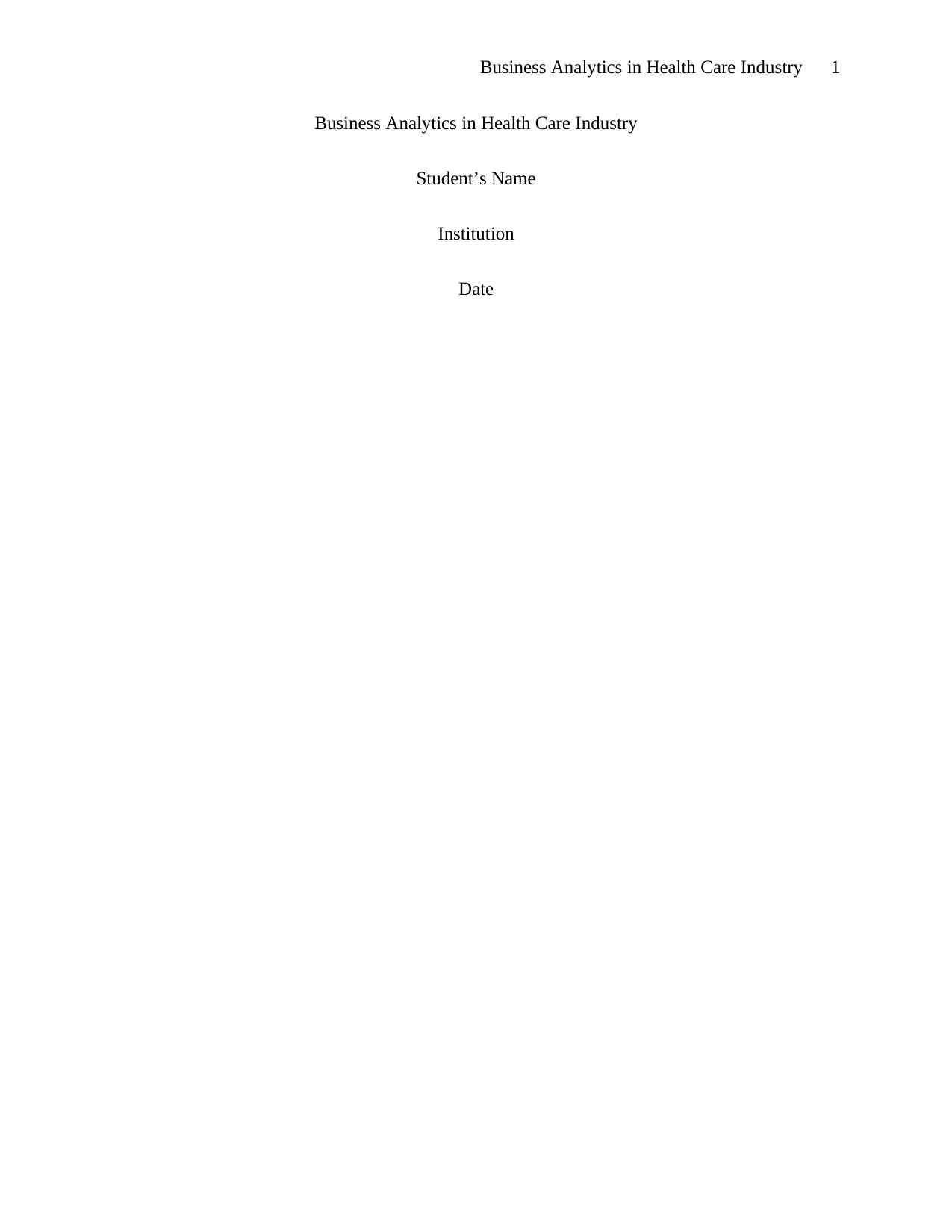
Business Analytics in Health Care Industry 1
Business Analytics in Health Care Industry
Student’s Name
Institution
Date
Business Analytics in Health Care Industry
Student’s Name
Institution
Date
Paraphrase This Document
Need a fresh take? Get an instant paraphrase of this document with our AI Paraphraser
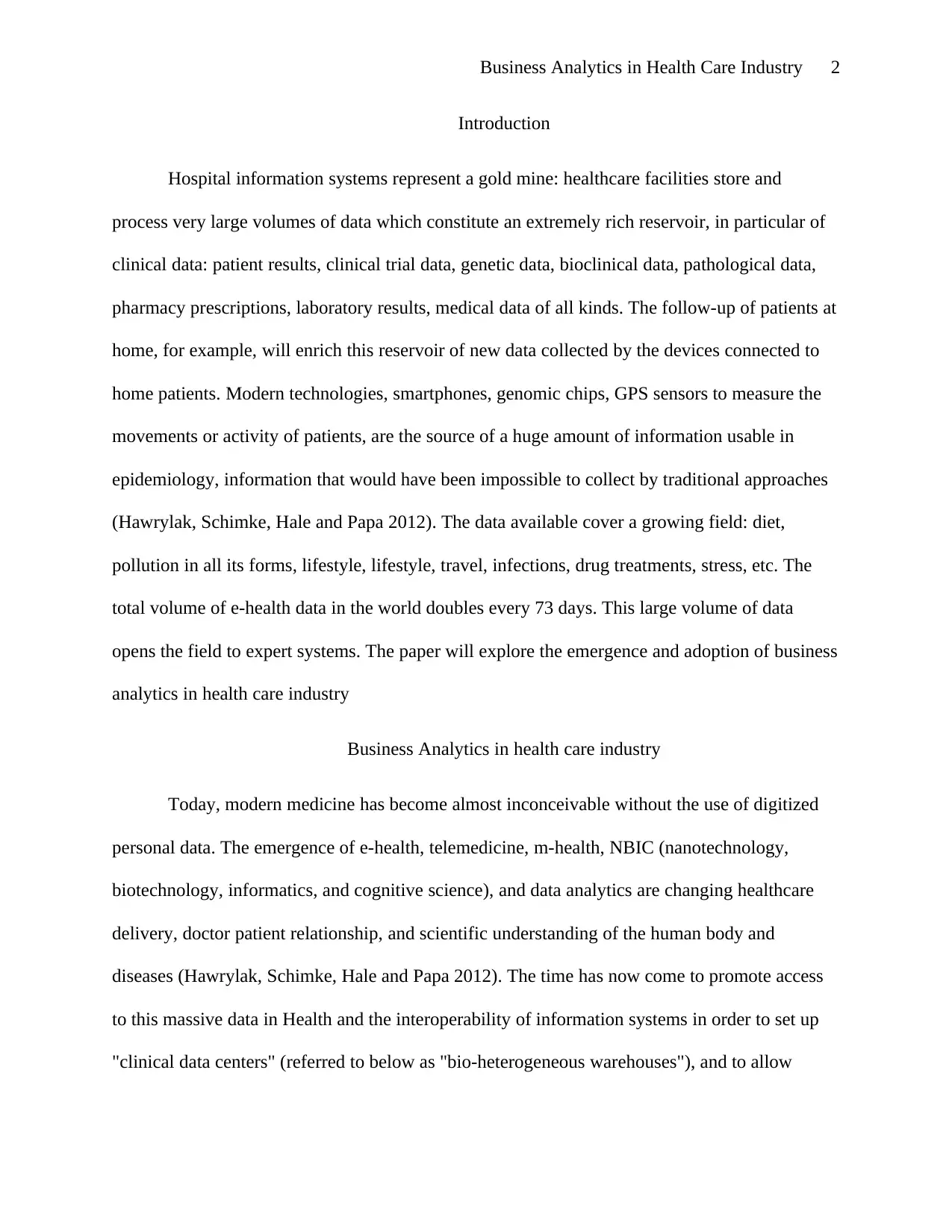
Business Analytics in Health Care Industry 2
Introduction
Hospital information systems represent a gold mine: healthcare facilities store and
process very large volumes of data which constitute an extremely rich reservoir, in particular of
clinical data: patient results, clinical trial data, genetic data, bioclinical data, pathological data,
pharmacy prescriptions, laboratory results, medical data of all kinds. The follow-up of patients at
home, for example, will enrich this reservoir of new data collected by the devices connected to
home patients. Modern technologies, smartphones, genomic chips, GPS sensors to measure the
movements or activity of patients, are the source of a huge amount of information usable in
epidemiology, information that would have been impossible to collect by traditional approaches
(Hawrylak, Schimke, Hale and Papa 2012). The data available cover a growing field: diet,
pollution in all its forms, lifestyle, lifestyle, travel, infections, drug treatments, stress, etc. The
total volume of e-health data in the world doubles every 73 days. This large volume of data
opens the field to expert systems. The paper will explore the emergence and adoption of business
analytics in health care industry
Business Analytics in health care industry
Today, modern medicine has become almost inconceivable without the use of digitized
personal data. The emergence of e-health, telemedicine, m-health, NBIC (nanotechnology,
biotechnology, informatics, and cognitive science), and data analytics are changing healthcare
delivery, doctor patient relationship, and scientific understanding of the human body and
diseases (Hawrylak, Schimke, Hale and Papa 2012). The time has now come to promote access
to this massive data in Health and the interoperability of information systems in order to set up
"clinical data centers" (referred to below as "bio-heterogeneous warehouses"), and to allow
Introduction
Hospital information systems represent a gold mine: healthcare facilities store and
process very large volumes of data which constitute an extremely rich reservoir, in particular of
clinical data: patient results, clinical trial data, genetic data, bioclinical data, pathological data,
pharmacy prescriptions, laboratory results, medical data of all kinds. The follow-up of patients at
home, for example, will enrich this reservoir of new data collected by the devices connected to
home patients. Modern technologies, smartphones, genomic chips, GPS sensors to measure the
movements or activity of patients, are the source of a huge amount of information usable in
epidemiology, information that would have been impossible to collect by traditional approaches
(Hawrylak, Schimke, Hale and Papa 2012). The data available cover a growing field: diet,
pollution in all its forms, lifestyle, lifestyle, travel, infections, drug treatments, stress, etc. The
total volume of e-health data in the world doubles every 73 days. This large volume of data
opens the field to expert systems. The paper will explore the emergence and adoption of business
analytics in health care industry
Business Analytics in health care industry
Today, modern medicine has become almost inconceivable without the use of digitized
personal data. The emergence of e-health, telemedicine, m-health, NBIC (nanotechnology,
biotechnology, informatics, and cognitive science), and data analytics are changing healthcare
delivery, doctor patient relationship, and scientific understanding of the human body and
diseases (Hawrylak, Schimke, Hale and Papa 2012). The time has now come to promote access
to this massive data in Health and the interoperability of information systems in order to set up
"clinical data centers" (referred to below as "bio-heterogeneous warehouses"), and to allow
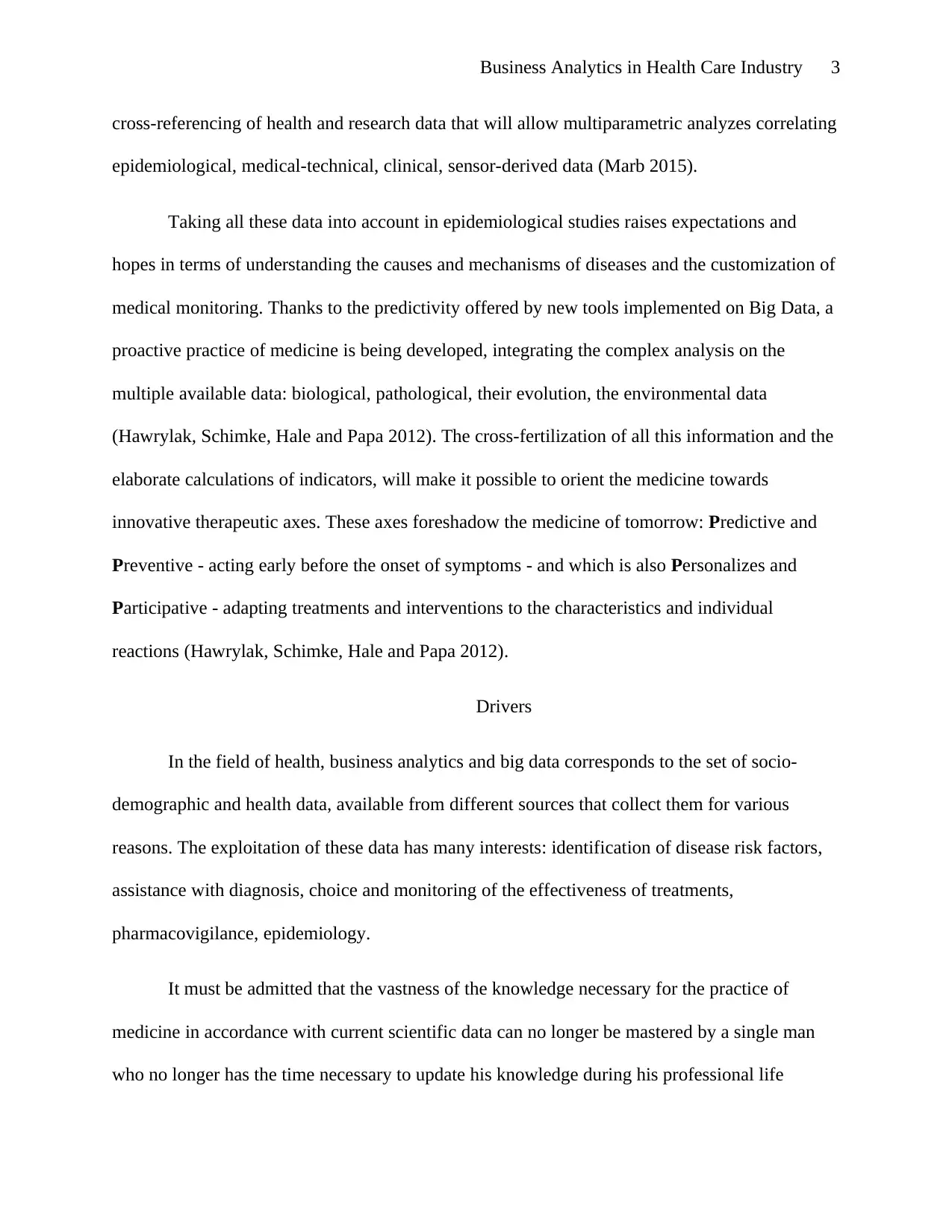
Business Analytics in Health Care Industry 3
cross-referencing of health and research data that will allow multiparametric analyzes correlating
epidemiological, medical-technical, clinical, sensor-derived data (Marb 2015).
Taking all these data into account in epidemiological studies raises expectations and
hopes in terms of understanding the causes and mechanisms of diseases and the customization of
medical monitoring. Thanks to the predictivity offered by new tools implemented on Big Data, a
proactive practice of medicine is being developed, integrating the complex analysis on the
multiple available data: biological, pathological, their evolution, the environmental data
(Hawrylak, Schimke, Hale and Papa 2012). The cross-fertilization of all this information and the
elaborate calculations of indicators, will make it possible to orient the medicine towards
innovative therapeutic axes. These axes foreshadow the medicine of tomorrow: Predictive and
Preventive - acting early before the onset of symptoms - and which is also Personalizes and
Participative - adapting treatments and interventions to the characteristics and individual
reactions (Hawrylak, Schimke, Hale and Papa 2012).
Drivers
In the field of health, business analytics and big data corresponds to the set of socio-
demographic and health data, available from different sources that collect them for various
reasons. The exploitation of these data has many interests: identification of disease risk factors,
assistance with diagnosis, choice and monitoring of the effectiveness of treatments,
pharmacovigilance, epidemiology.
It must be admitted that the vastness of the knowledge necessary for the practice of
medicine in accordance with current scientific data can no longer be mastered by a single man
who no longer has the time necessary to update his knowledge during his professional life
cross-referencing of health and research data that will allow multiparametric analyzes correlating
epidemiological, medical-technical, clinical, sensor-derived data (Marb 2015).
Taking all these data into account in epidemiological studies raises expectations and
hopes in terms of understanding the causes and mechanisms of diseases and the customization of
medical monitoring. Thanks to the predictivity offered by new tools implemented on Big Data, a
proactive practice of medicine is being developed, integrating the complex analysis on the
multiple available data: biological, pathological, their evolution, the environmental data
(Hawrylak, Schimke, Hale and Papa 2012). The cross-fertilization of all this information and the
elaborate calculations of indicators, will make it possible to orient the medicine towards
innovative therapeutic axes. These axes foreshadow the medicine of tomorrow: Predictive and
Preventive - acting early before the onset of symptoms - and which is also Personalizes and
Participative - adapting treatments and interventions to the characteristics and individual
reactions (Hawrylak, Schimke, Hale and Papa 2012).
Drivers
In the field of health, business analytics and big data corresponds to the set of socio-
demographic and health data, available from different sources that collect them for various
reasons. The exploitation of these data has many interests: identification of disease risk factors,
assistance with diagnosis, choice and monitoring of the effectiveness of treatments,
pharmacovigilance, epidemiology.
It must be admitted that the vastness of the knowledge necessary for the practice of
medicine in accordance with current scientific data can no longer be mastered by a single man
who no longer has the time necessary to update his knowledge during his professional life
⊘ This is a preview!⊘
Do you want full access?
Subscribe today to unlock all pages.

Trusted by 1+ million students worldwide
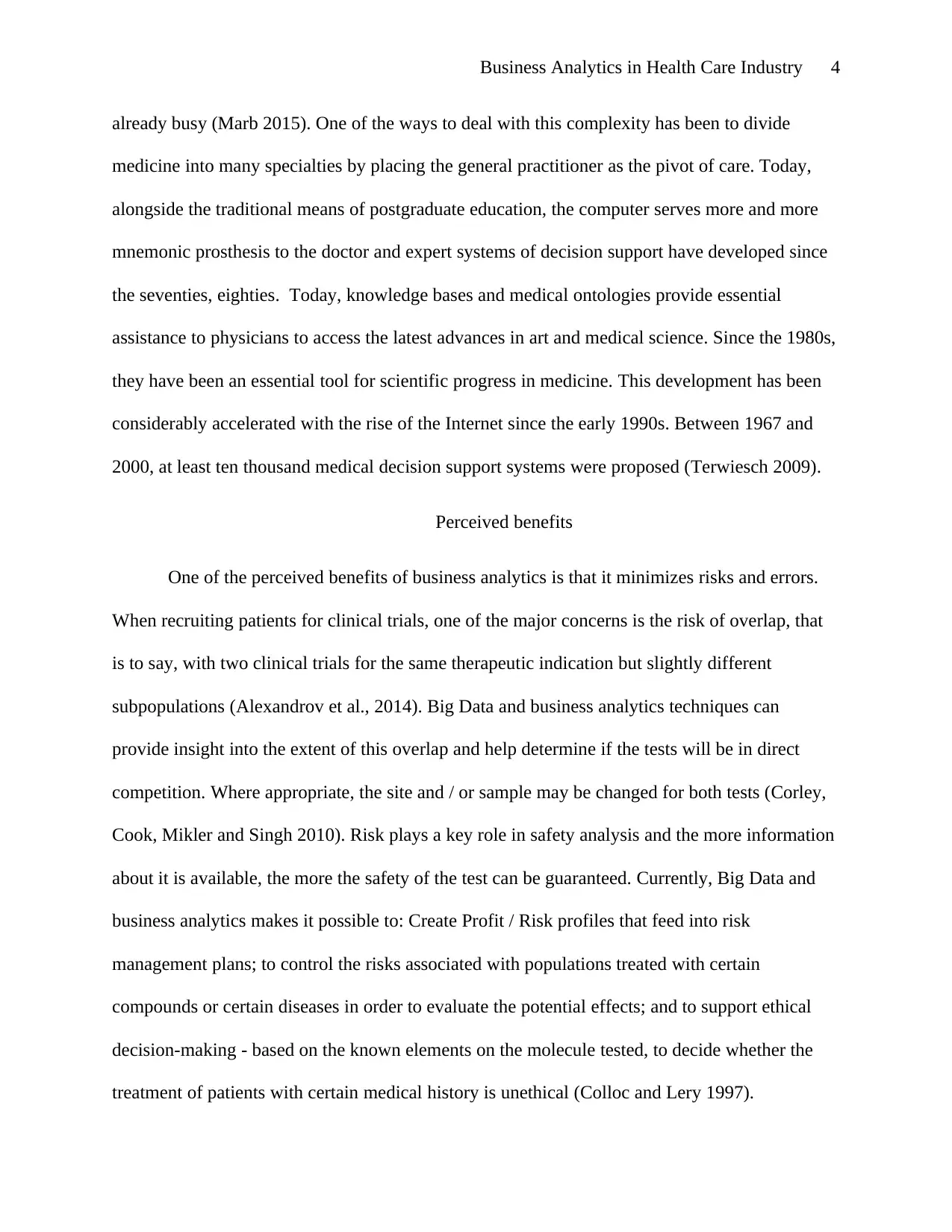
Business Analytics in Health Care Industry 4
already busy (Marb 2015). One of the ways to deal with this complexity has been to divide
medicine into many specialties by placing the general practitioner as the pivot of care. Today,
alongside the traditional means of postgraduate education, the computer serves more and more
mnemonic prosthesis to the doctor and expert systems of decision support have developed since
the seventies, eighties. Today, knowledge bases and medical ontologies provide essential
assistance to physicians to access the latest advances in art and medical science. Since the 1980s,
they have been an essential tool for scientific progress in medicine. This development has been
considerably accelerated with the rise of the Internet since the early 1990s. Between 1967 and
2000, at least ten thousand medical decision support systems were proposed (Terwiesch 2009).
Perceived benefits
One of the perceived benefits of business analytics is that it minimizes risks and errors.
When recruiting patients for clinical trials, one of the major concerns is the risk of overlap, that
is to say, with two clinical trials for the same therapeutic indication but slightly different
subpopulations (Alexandrov et al., 2014). Big Data and business analytics techniques can
provide insight into the extent of this overlap and help determine if the tests will be in direct
competition. Where appropriate, the site and / or sample may be changed for both tests (Corley,
Cook, Mikler and Singh 2010). Risk plays a key role in safety analysis and the more information
about it is available, the more the safety of the test can be guaranteed. Currently, Big Data and
business analytics makes it possible to: Create Profit / Risk profiles that feed into risk
management plans; to control the risks associated with populations treated with certain
compounds or certain diseases in order to evaluate the potential effects; and to support ethical
decision-making - based on the known elements on the molecule tested, to decide whether the
treatment of patients with certain medical history is unethical (Colloc and Lery 1997).
already busy (Marb 2015). One of the ways to deal with this complexity has been to divide
medicine into many specialties by placing the general practitioner as the pivot of care. Today,
alongside the traditional means of postgraduate education, the computer serves more and more
mnemonic prosthesis to the doctor and expert systems of decision support have developed since
the seventies, eighties. Today, knowledge bases and medical ontologies provide essential
assistance to physicians to access the latest advances in art and medical science. Since the 1980s,
they have been an essential tool for scientific progress in medicine. This development has been
considerably accelerated with the rise of the Internet since the early 1990s. Between 1967 and
2000, at least ten thousand medical decision support systems were proposed (Terwiesch 2009).
Perceived benefits
One of the perceived benefits of business analytics is that it minimizes risks and errors.
When recruiting patients for clinical trials, one of the major concerns is the risk of overlap, that
is to say, with two clinical trials for the same therapeutic indication but slightly different
subpopulations (Alexandrov et al., 2014). Big Data and business analytics techniques can
provide insight into the extent of this overlap and help determine if the tests will be in direct
competition. Where appropriate, the site and / or sample may be changed for both tests (Corley,
Cook, Mikler and Singh 2010). Risk plays a key role in safety analysis and the more information
about it is available, the more the safety of the test can be guaranteed. Currently, Big Data and
business analytics makes it possible to: Create Profit / Risk profiles that feed into risk
management plans; to control the risks associated with populations treated with certain
compounds or certain diseases in order to evaluate the potential effects; and to support ethical
decision-making - based on the known elements on the molecule tested, to decide whether the
treatment of patients with certain medical history is unethical (Colloc and Lery 1997).
Paraphrase This Document
Need a fresh take? Get an instant paraphrase of this document with our AI Paraphraser
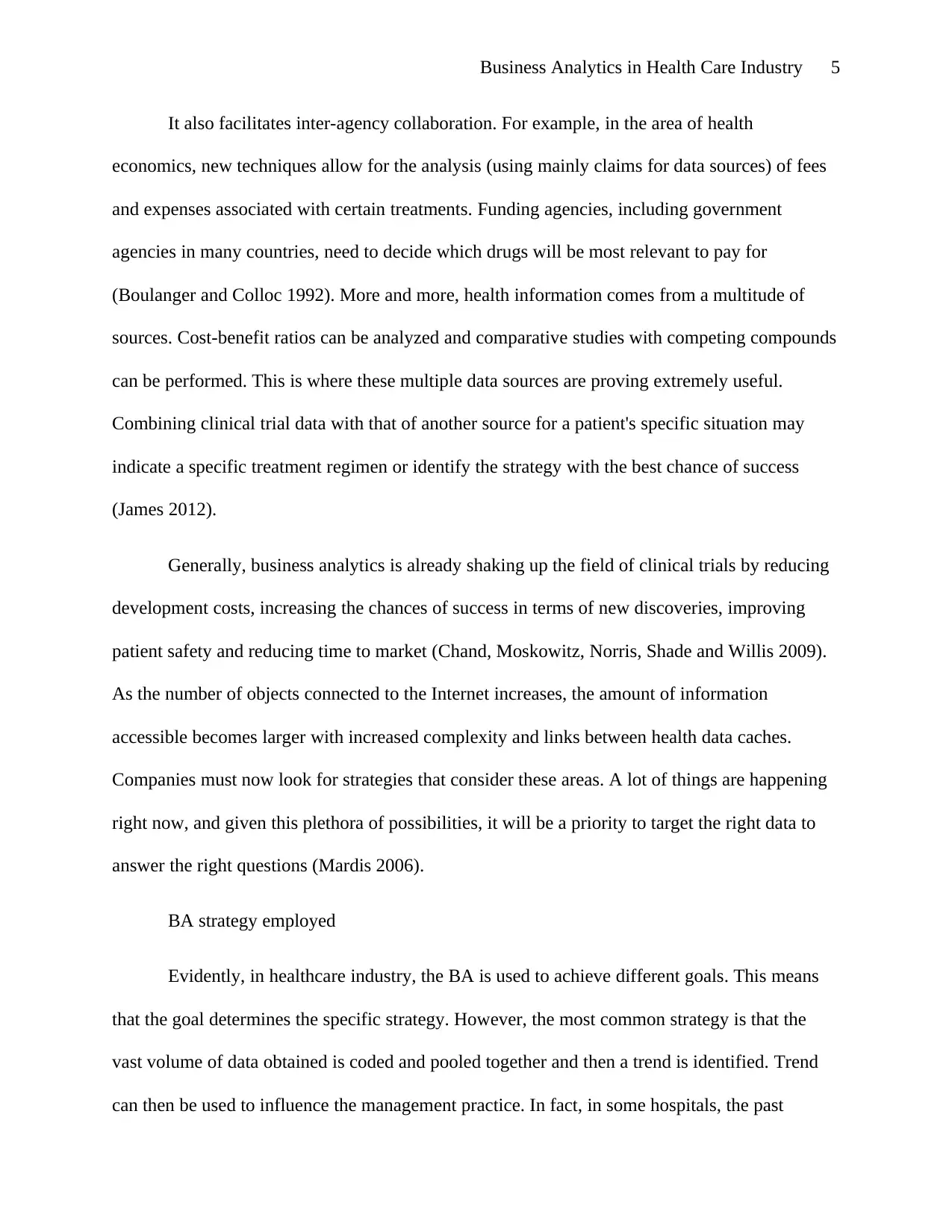
Business Analytics in Health Care Industry 5
It also facilitates inter-agency collaboration. For example, in the area of health
economics, new techniques allow for the analysis (using mainly claims for data sources) of fees
and expenses associated with certain treatments. Funding agencies, including government
agencies in many countries, need to decide which drugs will be most relevant to pay for
(Boulanger and Colloc 1992). More and more, health information comes from a multitude of
sources. Cost-benefit ratios can be analyzed and comparative studies with competing compounds
can be performed. This is where these multiple data sources are proving extremely useful.
Combining clinical trial data with that of another source for a patient's specific situation may
indicate a specific treatment regimen or identify the strategy with the best chance of success
(James 2012).
Generally, business analytics is already shaking up the field of clinical trials by reducing
development costs, increasing the chances of success in terms of new discoveries, improving
patient safety and reducing time to market (Chand, Moskowitz, Norris, Shade and Willis 2009).
As the number of objects connected to the Internet increases, the amount of information
accessible becomes larger with increased complexity and links between health data caches.
Companies must now look for strategies that consider these areas. A lot of things are happening
right now, and given this plethora of possibilities, it will be a priority to target the right data to
answer the right questions (Mardis 2006).
BA strategy employed
Evidently, in healthcare industry, the BA is used to achieve different goals. This means
that the goal determines the specific strategy. However, the most common strategy is that the
vast volume of data obtained is coded and pooled together and then a trend is identified. Trend
can then be used to influence the management practice. In fact, in some hospitals, the past
It also facilitates inter-agency collaboration. For example, in the area of health
economics, new techniques allow for the analysis (using mainly claims for data sources) of fees
and expenses associated with certain treatments. Funding agencies, including government
agencies in many countries, need to decide which drugs will be most relevant to pay for
(Boulanger and Colloc 1992). More and more, health information comes from a multitude of
sources. Cost-benefit ratios can be analyzed and comparative studies with competing compounds
can be performed. This is where these multiple data sources are proving extremely useful.
Combining clinical trial data with that of another source for a patient's specific situation may
indicate a specific treatment regimen or identify the strategy with the best chance of success
(James 2012).
Generally, business analytics is already shaking up the field of clinical trials by reducing
development costs, increasing the chances of success in terms of new discoveries, improving
patient safety and reducing time to market (Chand, Moskowitz, Norris, Shade and Willis 2009).
As the number of objects connected to the Internet increases, the amount of information
accessible becomes larger with increased complexity and links between health data caches.
Companies must now look for strategies that consider these areas. A lot of things are happening
right now, and given this plethora of possibilities, it will be a priority to target the right data to
answer the right questions (Mardis 2006).
BA strategy employed
Evidently, in healthcare industry, the BA is used to achieve different goals. This means
that the goal determines the specific strategy. However, the most common strategy is that the
vast volume of data obtained is coded and pooled together and then a trend is identified. Trend
can then be used to influence the management practice. In fact, in some hospitals, the past

Business Analytics in Health Care Industry 6
experiences can be analyzed and themes created on how a given disease can be managed based
on similarity of past experiences. For example, the HealthMap site aims to predict the occurrence
of epidemics from data from many sources.
Challenges
The key challenge facing business analytics in health care industry is the technical
complexities. The huge volumes of data now available raise technical challenges regarding
storage and operational capabilities. Increasingly complex computer and statistical programs and
algorithms are needed. Research organizations all have storage servers and supercomputers. In
most cases, given their cost, these platforms are pooled (Blumenthal and Tavenner 2010).
Another problem is that big data is quite fragmented. The information collected is indeed
increasingly heterogeneous, by: their nature (genomic, physiological, biological, clinical,
social ...), their format (text, numerical values, signals, 2D and 3D images, genomic
sequences ...), their dispersion within several information systems (hospital groups, research
laboratories, public databases, etc.). Consequently, on order to make their processing and
exploitation possible, this complex information must be acquired in a structured manner and
coded before it can be integrated into databases or data warehouses. Due to this challenge, most
of the hospitals have problems in compiling all data collected (pharmacy, biology, imaging,
genomics, medico-economic, clinical ...) in biomedical data warehouses, searchable by
researchers via web interfaces (Lovejoy and Desmond 2011).
Actual benefits
experiences can be analyzed and themes created on how a given disease can be managed based
on similarity of past experiences. For example, the HealthMap site aims to predict the occurrence
of epidemics from data from many sources.
Challenges
The key challenge facing business analytics in health care industry is the technical
complexities. The huge volumes of data now available raise technical challenges regarding
storage and operational capabilities. Increasingly complex computer and statistical programs and
algorithms are needed. Research organizations all have storage servers and supercomputers. In
most cases, given their cost, these platforms are pooled (Blumenthal and Tavenner 2010).
Another problem is that big data is quite fragmented. The information collected is indeed
increasingly heterogeneous, by: their nature (genomic, physiological, biological, clinical,
social ...), their format (text, numerical values, signals, 2D and 3D images, genomic
sequences ...), their dispersion within several information systems (hospital groups, research
laboratories, public databases, etc.). Consequently, on order to make their processing and
exploitation possible, this complex information must be acquired in a structured manner and
coded before it can be integrated into databases or data warehouses. Due to this challenge, most
of the hospitals have problems in compiling all data collected (pharmacy, biology, imaging,
genomics, medico-economic, clinical ...) in biomedical data warehouses, searchable by
researchers via web interfaces (Lovejoy and Desmond 2011).
Actual benefits
⊘ This is a preview!⊘
Do you want full access?
Subscribe today to unlock all pages.

Trusted by 1+ million students worldwide

Business Analytics in Health Care Industry 7
The first benefit is that business analytics facilitate prevention and management of
diseases. Long - term multidimensional data collected over large populations allow the
identification of risk factors for certain diseases such as cancer, diabetes, asthma and
neurodegenerative diseases (Terwiesch 2012). These factors are then used to build prevention
messages, and set up programs for at-risk populations. Big data also allows the development of
diagnostic support systems and tools for customizing treatments (Mandl and Kohane 2012).
These systems are based on the treatment of large masses of individual clinical data. In this vein,
IBM's IBM supercomputer makes it possible, for example, to analyze in a few minutes the result
of genomic sequencing of cancer patients, to compare the data obtained with those already
available, and thus to propose a personalized therapeutic strategy (Crandall, Kappelman &
Colletti et al 2011). In the absence of this tool, this analysis work takes several weeks. Interested
clinics and hospitals partner with IBM who owns this supercomputer and provides the results.
Business analytics can also be used to check the effectiveness of a treatment (Marsolo 2013). For
example, in the field of vaccines, clinicians today measure hundreds of parameters during
clinical trials: cell counts, cellular functionality, expression of genes of interest ... whereas a few
years ago, was limited to the concentration of antibody (Froehle and Magazine 2013).
Ultimately, this evolution, the massive data that it generates and the capacity to analyze them,
could make it possible to verify that a vaccination worked well after only one hour, starting from
a micro drop of blood (Lery and Colloc 2008).
Business analytics also helps in predicting diseases. Having a lot of information on the
state of health of individuals in a given region can be used to identify the rise in the incidence of
diseases or risk behaviors, and to alert health authorities. Thus, the HealthMap site aims to
predict the occurrence of epidemics from data from many sources. Developed by American
The first benefit is that business analytics facilitate prevention and management of
diseases. Long - term multidimensional data collected over large populations allow the
identification of risk factors for certain diseases such as cancer, diabetes, asthma and
neurodegenerative diseases (Terwiesch 2012). These factors are then used to build prevention
messages, and set up programs for at-risk populations. Big data also allows the development of
diagnostic support systems and tools for customizing treatments (Mandl and Kohane 2012).
These systems are based on the treatment of large masses of individual clinical data. In this vein,
IBM's IBM supercomputer makes it possible, for example, to analyze in a few minutes the result
of genomic sequencing of cancer patients, to compare the data obtained with those already
available, and thus to propose a personalized therapeutic strategy (Crandall, Kappelman &
Colletti et al 2011). In the absence of this tool, this analysis work takes several weeks. Interested
clinics and hospitals partner with IBM who owns this supercomputer and provides the results.
Business analytics can also be used to check the effectiveness of a treatment (Marsolo 2013). For
example, in the field of vaccines, clinicians today measure hundreds of parameters during
clinical trials: cell counts, cellular functionality, expression of genes of interest ... whereas a few
years ago, was limited to the concentration of antibody (Froehle and Magazine 2013).
Ultimately, this evolution, the massive data that it generates and the capacity to analyze them,
could make it possible to verify that a vaccination worked well after only one hour, starting from
a micro drop of blood (Lery and Colloc 2008).
Business analytics also helps in predicting diseases. Having a lot of information on the
state of health of individuals in a given region can be used to identify the rise in the incidence of
diseases or risk behaviors, and to alert health authorities. Thus, the HealthMap site aims to
predict the occurrence of epidemics from data from many sources. Developed by American
Paraphrase This Document
Need a fresh take? Get an instant paraphrase of this document with our AI Paraphraser
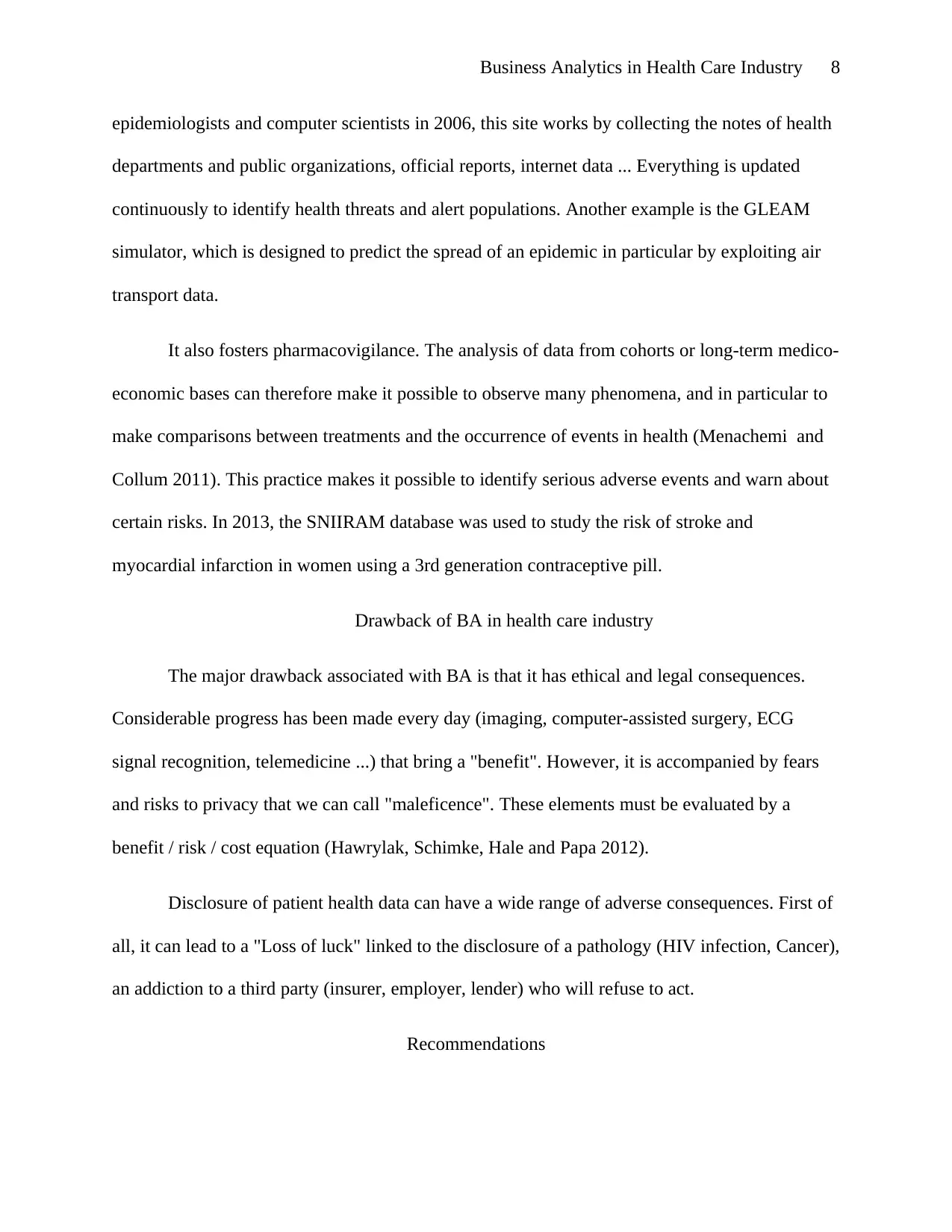
Business Analytics in Health Care Industry 8
epidemiologists and computer scientists in 2006, this site works by collecting the notes of health
departments and public organizations, official reports, internet data ... Everything is updated
continuously to identify health threats and alert populations. Another example is the GLEAM
simulator, which is designed to predict the spread of an epidemic in particular by exploiting air
transport data.
It also fosters pharmacovigilance. The analysis of data from cohorts or long-term medico-
economic bases can therefore make it possible to observe many phenomena, and in particular to
make comparisons between treatments and the occurrence of events in health (Menachemi and
Collum 2011). This practice makes it possible to identify serious adverse events and warn about
certain risks. In 2013, the SNIIRAM database was used to study the risk of stroke and
myocardial infarction in women using a 3rd generation contraceptive pill.
Drawback of BA in health care industry
The major drawback associated with BA is that it has ethical and legal consequences.
Considerable progress has been made every day (imaging, computer-assisted surgery, ECG
signal recognition, telemedicine ...) that bring a "benefit". However, it is accompanied by fears
and risks to privacy that we can call "maleficence". These elements must be evaluated by a
benefit / risk / cost equation (Hawrylak, Schimke, Hale and Papa 2012).
Disclosure of patient health data can have a wide range of adverse consequences. First of
all, it can lead to a "Loss of luck" linked to the disclosure of a pathology (HIV infection, Cancer),
an addiction to a third party (insurer, employer, lender) who will refuse to act.
Recommendations
epidemiologists and computer scientists in 2006, this site works by collecting the notes of health
departments and public organizations, official reports, internet data ... Everything is updated
continuously to identify health threats and alert populations. Another example is the GLEAM
simulator, which is designed to predict the spread of an epidemic in particular by exploiting air
transport data.
It also fosters pharmacovigilance. The analysis of data from cohorts or long-term medico-
economic bases can therefore make it possible to observe many phenomena, and in particular to
make comparisons between treatments and the occurrence of events in health (Menachemi and
Collum 2011). This practice makes it possible to identify serious adverse events and warn about
certain risks. In 2013, the SNIIRAM database was used to study the risk of stroke and
myocardial infarction in women using a 3rd generation contraceptive pill.
Drawback of BA in health care industry
The major drawback associated with BA is that it has ethical and legal consequences.
Considerable progress has been made every day (imaging, computer-assisted surgery, ECG
signal recognition, telemedicine ...) that bring a "benefit". However, it is accompanied by fears
and risks to privacy that we can call "maleficence". These elements must be evaluated by a
benefit / risk / cost equation (Hawrylak, Schimke, Hale and Papa 2012).
Disclosure of patient health data can have a wide range of adverse consequences. First of
all, it can lead to a "Loss of luck" linked to the disclosure of a pathology (HIV infection, Cancer),
an addiction to a third party (insurer, employer, lender) who will refuse to act.
Recommendations
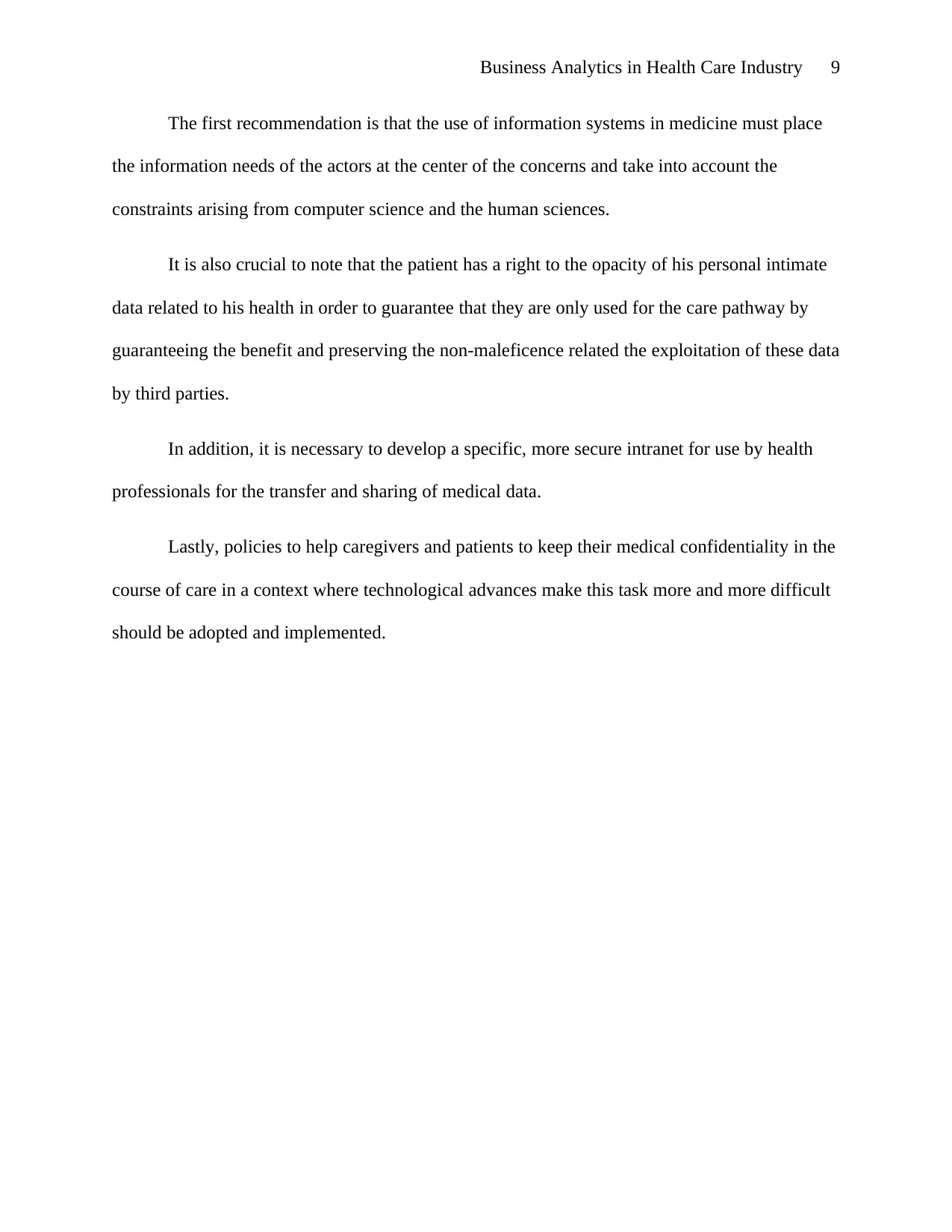
Business Analytics in Health Care Industry 9
The first recommendation is that the use of information systems in medicine must place
the information needs of the actors at the center of the concerns and take into account the
constraints arising from computer science and the human sciences.
It is also crucial to note that the patient has a right to the opacity of his personal intimate
data related to his health in order to guarantee that they are only used for the care pathway by
guaranteeing the benefit and preserving the non-maleficence related the exploitation of these data
by third parties.
In addition, it is necessary to develop a specific, more secure intranet for use by health
professionals for the transfer and sharing of medical data.
Lastly, policies to help caregivers and patients to keep their medical confidentiality in the
course of care in a context where technological advances make this task more and more difficult
should be adopted and implemented.
The first recommendation is that the use of information systems in medicine must place
the information needs of the actors at the center of the concerns and take into account the
constraints arising from computer science and the human sciences.
It is also crucial to note that the patient has a right to the opacity of his personal intimate
data related to his health in order to guarantee that they are only used for the care pathway by
guaranteeing the benefit and preserving the non-maleficence related the exploitation of these data
by third parties.
In addition, it is necessary to develop a specific, more secure intranet for use by health
professionals for the transfer and sharing of medical data.
Lastly, policies to help caregivers and patients to keep their medical confidentiality in the
course of care in a context where technological advances make this task more and more difficult
should be adopted and implemented.
⊘ This is a preview!⊘
Do you want full access?
Subscribe today to unlock all pages.

Trusted by 1+ million students worldwide
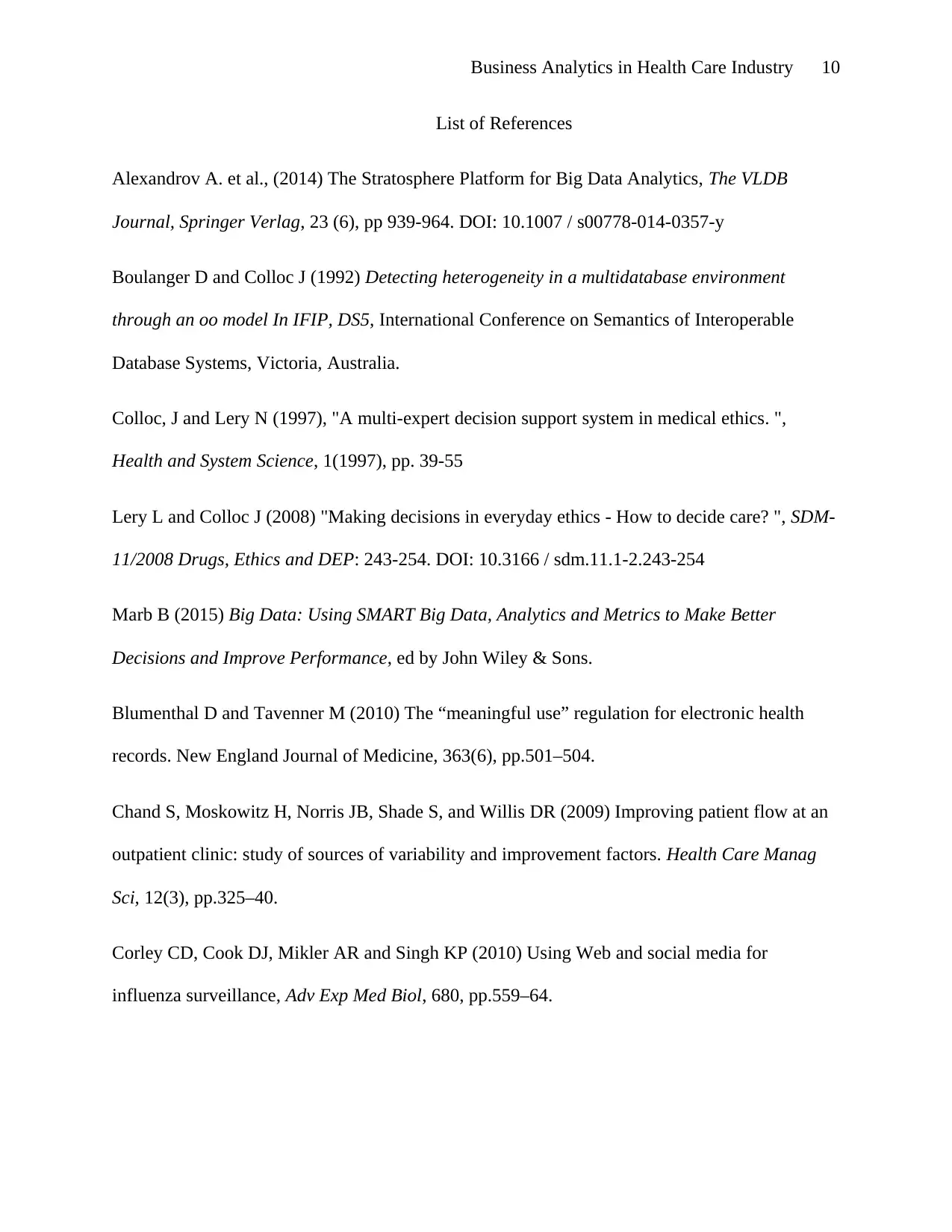
Business Analytics in Health Care Industry 10
List of References
Alexandrov A. et al., (2014) The Stratosphere Platform for Big Data Analytics, The VLDB
Journal, Springer Verlag, 23 (6), pp 939-964. DOI: 10.1007 / s00778-014-0357-y
Boulanger D and Colloc J (1992) Detecting heterogeneity in a multidatabase environment
through an oo model In IFIP, DS5, International Conference on Semantics of Interoperable
Database Systems, Victoria, Australia.
Colloc, J and Lery N (1997), "A multi-expert decision support system in medical ethics. ",
Health and System Science, 1(1997), pp. 39-55
Lery L and Colloc J (2008) "Making decisions in everyday ethics - How to decide care? ", SDM-
11/2008 Drugs, Ethics and DEP: 243-254. DOI: 10.3166 / sdm.11.1-2.243-254
Marb B (2015) Big Data: Using SMART Big Data, Analytics and Metrics to Make Better
Decisions and Improve Performance, ed by John Wiley & Sons.
Blumenthal D and Tavenner M (2010) The “meaningful use” regulation for electronic health
records. New England Journal of Medicine, 363(6), pp.501–504.
Chand S, Moskowitz H, Norris JB, Shade S, and Willis DR (2009) Improving patient flow at an
outpatient clinic: study of sources of variability and improvement factors. Health Care Manag
Sci, 12(3), pp.325–40.
Corley CD, Cook DJ, Mikler AR and Singh KP (2010) Using Web and social media for
influenza surveillance, Adv Exp Med Biol, 680, pp.559–64.
List of References
Alexandrov A. et al., (2014) The Stratosphere Platform for Big Data Analytics, The VLDB
Journal, Springer Verlag, 23 (6), pp 939-964. DOI: 10.1007 / s00778-014-0357-y
Boulanger D and Colloc J (1992) Detecting heterogeneity in a multidatabase environment
through an oo model In IFIP, DS5, International Conference on Semantics of Interoperable
Database Systems, Victoria, Australia.
Colloc, J and Lery N (1997), "A multi-expert decision support system in medical ethics. ",
Health and System Science, 1(1997), pp. 39-55
Lery L and Colloc J (2008) "Making decisions in everyday ethics - How to decide care? ", SDM-
11/2008 Drugs, Ethics and DEP: 243-254. DOI: 10.3166 / sdm.11.1-2.243-254
Marb B (2015) Big Data: Using SMART Big Data, Analytics and Metrics to Make Better
Decisions and Improve Performance, ed by John Wiley & Sons.
Blumenthal D and Tavenner M (2010) The “meaningful use” regulation for electronic health
records. New England Journal of Medicine, 363(6), pp.501–504.
Chand S, Moskowitz H, Norris JB, Shade S, and Willis DR (2009) Improving patient flow at an
outpatient clinic: study of sources of variability and improvement factors. Health Care Manag
Sci, 12(3), pp.325–40.
Corley CD, Cook DJ, Mikler AR and Singh KP (2010) Using Web and social media for
influenza surveillance, Adv Exp Med Biol, 680, pp.559–64.
Paraphrase This Document
Need a fresh take? Get an instant paraphrase of this document with our AI Paraphraser
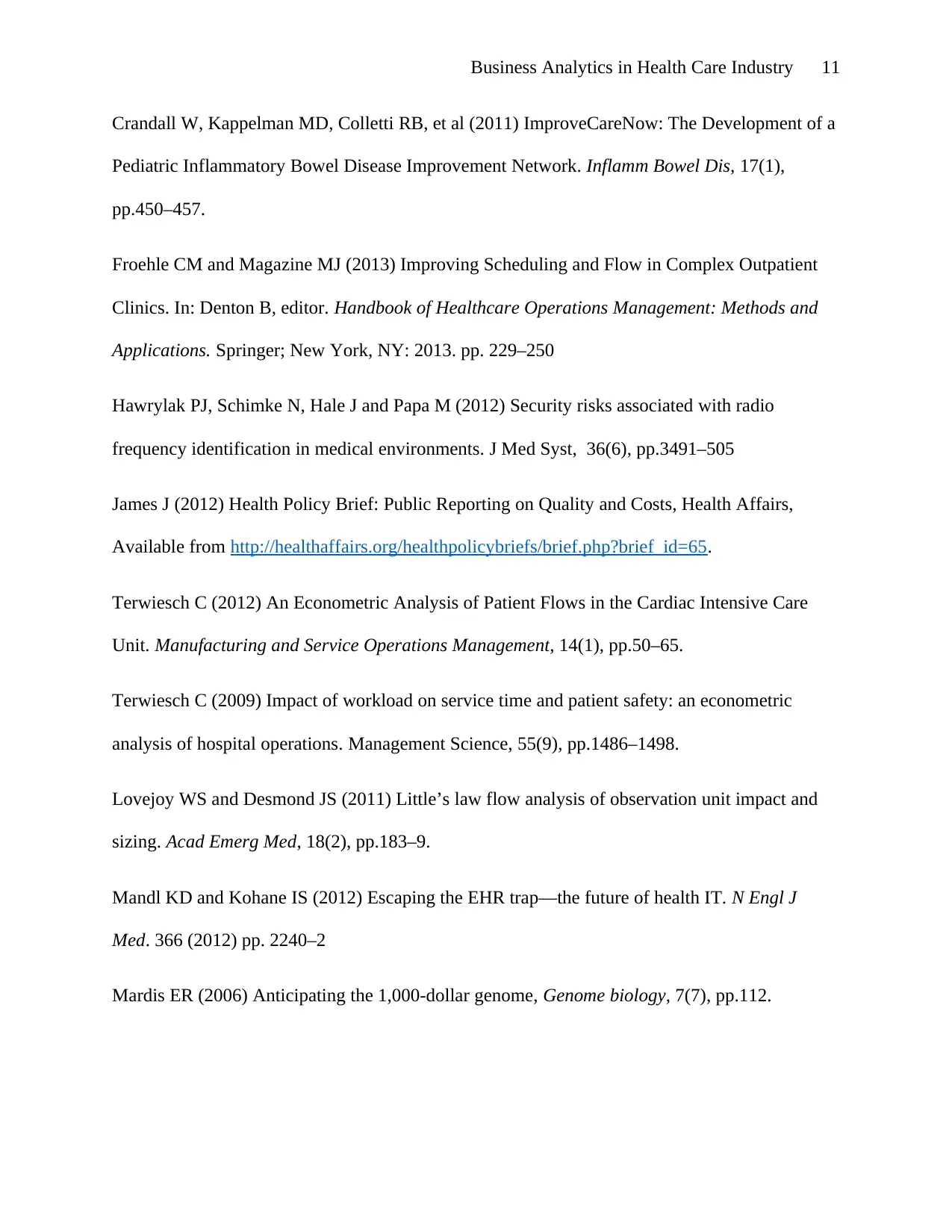
Business Analytics in Health Care Industry 11
Crandall W, Kappelman MD, Colletti RB, et al (2011) ImproveCareNow: The Development of a
Pediatric Inflammatory Bowel Disease Improvement Network. Inflamm Bowel Dis, 17(1),
pp.450–457.
Froehle CM and Magazine MJ (2013) Improving Scheduling and Flow in Complex Outpatient
Clinics. In: Denton B, editor. Handbook of Healthcare Operations Management: Methods and
Applications. Springer; New York, NY: 2013. pp. 229–250
Hawrylak PJ, Schimke N, Hale J and Papa M (2012) Security risks associated with radio
frequency identification in medical environments. J Med Syst, 36(6), pp.3491–505
James J (2012) Health Policy Brief: Public Reporting on Quality and Costs, Health Affairs,
Available from http://healthaffairs.org/healthpolicybriefs/brief.php?brief_id=65.
Terwiesch C (2012) An Econometric Analysis of Patient Flows in the Cardiac Intensive Care
Unit. Manufacturing and Service Operations Management, 14(1), pp.50–65.
Terwiesch C (2009) Impact of workload on service time and patient safety: an econometric
analysis of hospital operations. Management Science, 55(9), pp.1486–1498.
Lovejoy WS and Desmond JS (2011) Little’s law flow analysis of observation unit impact and
sizing. Acad Emerg Med, 18(2), pp.183–9.
Mandl KD and Kohane IS (2012) Escaping the EHR trap—the future of health IT. N Engl J
Med. 366 (2012) pp. 2240–2
Mardis ER (2006) Anticipating the 1,000-dollar genome, Genome biology, 7(7), pp.112.
Crandall W, Kappelman MD, Colletti RB, et al (2011) ImproveCareNow: The Development of a
Pediatric Inflammatory Bowel Disease Improvement Network. Inflamm Bowel Dis, 17(1),
pp.450–457.
Froehle CM and Magazine MJ (2013) Improving Scheduling and Flow in Complex Outpatient
Clinics. In: Denton B, editor. Handbook of Healthcare Operations Management: Methods and
Applications. Springer; New York, NY: 2013. pp. 229–250
Hawrylak PJ, Schimke N, Hale J and Papa M (2012) Security risks associated with radio
frequency identification in medical environments. J Med Syst, 36(6), pp.3491–505
James J (2012) Health Policy Brief: Public Reporting on Quality and Costs, Health Affairs,
Available from http://healthaffairs.org/healthpolicybriefs/brief.php?brief_id=65.
Terwiesch C (2012) An Econometric Analysis of Patient Flows in the Cardiac Intensive Care
Unit. Manufacturing and Service Operations Management, 14(1), pp.50–65.
Terwiesch C (2009) Impact of workload on service time and patient safety: an econometric
analysis of hospital operations. Management Science, 55(9), pp.1486–1498.
Lovejoy WS and Desmond JS (2011) Little’s law flow analysis of observation unit impact and
sizing. Acad Emerg Med, 18(2), pp.183–9.
Mandl KD and Kohane IS (2012) Escaping the EHR trap—the future of health IT. N Engl J
Med. 366 (2012) pp. 2240–2
Mardis ER (2006) Anticipating the 1,000-dollar genome, Genome biology, 7(7), pp.112.
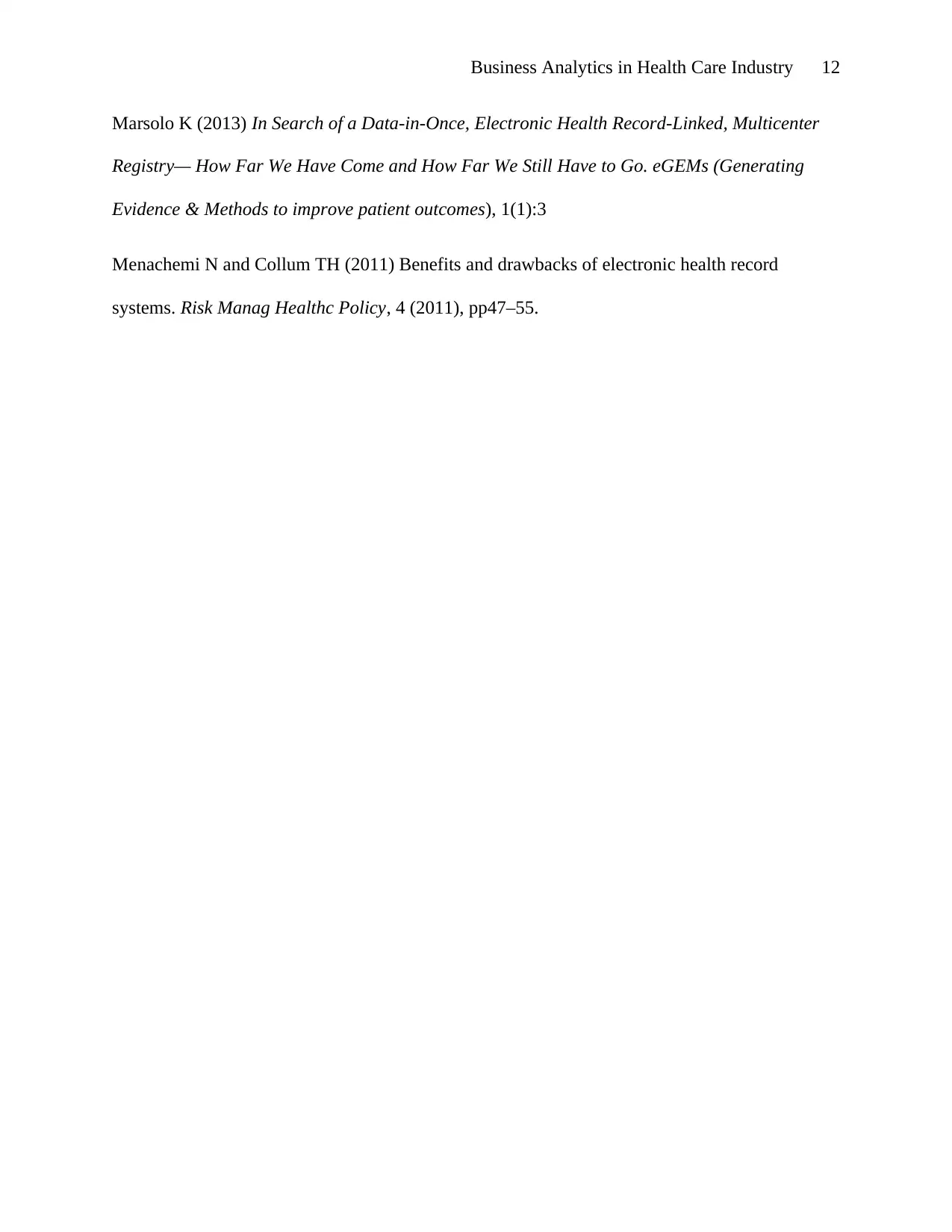
Business Analytics in Health Care Industry 12
Marsolo K (2013) In Search of a Data-in-Once, Electronic Health Record-Linked, Multicenter
Registry— How Far We Have Come and How Far We Still Have to Go. eGEMs (Generating
Evidence & Methods to improve patient outcomes), 1(1):3
Menachemi N and Collum TH (2011) Benefits and drawbacks of electronic health record
systems. Risk Manag Healthc Policy, 4 (2011), pp47–55.
Marsolo K (2013) In Search of a Data-in-Once, Electronic Health Record-Linked, Multicenter
Registry— How Far We Have Come and How Far We Still Have to Go. eGEMs (Generating
Evidence & Methods to improve patient outcomes), 1(1):3
Menachemi N and Collum TH (2011) Benefits and drawbacks of electronic health record
systems. Risk Manag Healthc Policy, 4 (2011), pp47–55.
⊘ This is a preview!⊘
Do you want full access?
Subscribe today to unlock all pages.

Trusted by 1+ million students worldwide
1 out of 12
Related Documents
Your All-in-One AI-Powered Toolkit for Academic Success.
+13062052269
info@desklib.com
Available 24*7 on WhatsApp / Email
![[object Object]](/_next/static/media/star-bottom.7253800d.svg)
Unlock your academic potential
Copyright © 2020–2026 A2Z Services. All Rights Reserved. Developed and managed by ZUCOL.





